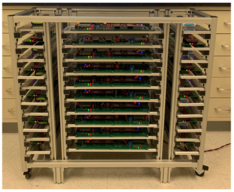Method for Statistical Design of Energy Storage Systems
TECHNOLOGY NUMBER: 2021-341

OVERVIEW
Creation of a novel second-use battery energy storage systems (2-BESS)- Permits a means to safely and efficiently repurpose automotive batteries
- Accounts for the heterogeneity of individual spent automotive batteries
BACKGROUND
Repurposing automotive batteries may have environmental and economic benefits. Extending the useful life of batteries can reduce waste and environmental pollution, while also decreasing the demand for new batteries and the environmental pollution that accompanies their production. Furthermore, repurposed automotive batteries may still hold a significant amount of energy after their usefulness in vehicles is done, yielding cost-effectiveness for their utilization in other settings. The challenge with second-use batteries centers on the uncertainty and diversity of the expected packs in terms of their chemistry, capacity and remaining useful life. Battery capacity and lifespan may differ depending on their original use, age, and condition. This variability complicates efforts to standardize the repurposing process and ensure consistent performance across different applications. So, a need exists for improvements in the safe and efficient repurposing of automotive batteries.
INNOVATION
Researchers have invented a new method for designing a second-use energy storage system (2-BESS) using a sparse hierarchical power processing architecture. This approach optimizes 2-BESS performance despite the diversity or heterogeneity of individual batteries, while concurrently reducing the cost of power conversion. Battery utilization is maximized by evaluating data regarding supply heterogeneity, testing accuracy, and aging or degradation to choose power converter ratings and power connectivity within 2-BESS. This results in higher battery utilization in capacity and power, while using lower power converters, at high heterogeneity. For example, the methodology provides greater than 90% battery utilization at 15% power or capacity heterogeneity with better than 1/6th in power converter cost compared to the best competing technology. This technology therefore provides a means by which to greatly reduce collective energy loss from the premature senescence of automotive batteries.
ADDITIONAL INFORMATION
Patent Application
Number: PCT/US2022/25990
Status: Filed
References
X. Cui et al., "Lite-Sparse Hierarchical Partial Power Processing for Parallel Batteries in Heterogeneous Energy Storage Systems," 2021 IEEE 22nd Workshop on Control and Modelling of Power Electronics (COMPEL), 2021, pp. 1-8, doi: https://doi.org/10.1109/COMPEL52922.2021.9645943